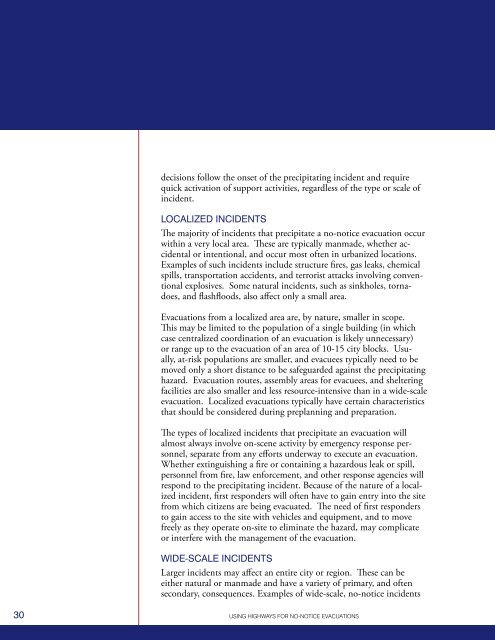using highways for no-notice evacuations - FHWA Operations - U.S. ...
using highways for no-notice evacuations - FHWA Operations - U.S. ...
using highways for no-notice evacuations - FHWA Operations - U.S. ...
Create successful ePaper yourself
Turn your PDF publications into a flip-book with our unique Google optimized e-Paper software.
decisions follow the onset of the precipitating incident and requirequick activation of support activities, regardless of the type or scale ofincident.LOCALIZED INCIDENTSThe majority of incidents that precipitate a <strong>no</strong>-<strong>no</strong>tice evacuation occurwithin a very local area. These are typically manmade, whether accidentalor intentional, and occur most often in urbanized locations.Examples of such incidents include structure fires, gas leaks, chemicalspills, transportation accidents, and terrorist attacks involving conventionalexplosives. Some natural incidents, such as sinkholes, tornadoes,and flashfloods, also affect only a small area.Evacuations from a localized area are, by nature, smaller in scope.This may be limited to the population of a single building (in whichcase centralized coordination of an evacuation is likely unnecessary)or range up to the evacuation of an area of 10-15 city blocks. Usually,at-risk populations are smaller, and evacuees typically need to bemoved only a short distance to be safeguarded against the precipitatinghazard. Evacuation routes, assembly areas <strong>for</strong> evacuees, and shelteringfacilities are also smaller and less resource-intensive than in a wide-scaleevacuation. Localized <strong>evacuations</strong> typically have certain characteristicsthat should be considered during preplanning and preparation.The types of localized incidents that precipitate an evacuation willalmost always involve on-scene activity by emergency response personnel,separate from any ef<strong>for</strong>ts underway to execute an evacuation.Whether extinguishing a fire or containing a hazardous leak or spill,personnel from fire, law en<strong>for</strong>cement, and other response agencies willrespond to the precipitating incident. Because of the nature of a localizedincident, first responders will often have to gain entry into the sitefrom which citizens are being evacuated. The need of first respondersto gain access to the site with vehicles and equipment, and to movefreely as they operate on-site to eliminate the hazard, may complicateor interfere with the management of the evacuation.WIDE-SCALE INCIDENTSLarger incidents may affect an entire city or region. These can beeither natural or manmade and have a variety of primary, and oftensecondary, consequences. Examples of wide-scale, <strong>no</strong>-<strong>no</strong>tice incidents30 USING HIGHWAYS FOR NO-NOTICE EVACUATIONS
















